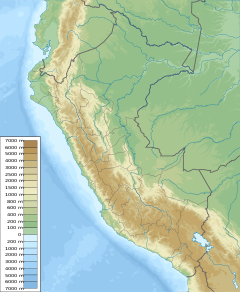Casiri (Tacna)
| Casiri | |
|---|---|
| Paugarani[1] | |
 Casiri volcanic complex | |
| Highest point | |
| Elevation | 5,650 m (18,540 ft) |
| Coordinates | 17°28′00″S 69°48′48″W / 17.46667°S 69.81333°W |
| Naming | |
| English translation | bawler |
| Language of name | Aymara |
| Geography | |
| Location | Peru, Tacna Region |
| Parent range | Andes, Barroso |
| Geology | |
| Rock age | Unknown[1] |
| Mountain type | Volcano |
| Volcanic arc/belt | Central Volcanic Zone |

Casiri (possibly from Aymara for bawler)[2] is a mountainous complex in the Barroso mountain range in the Andes of Peru, about 5,650 metres (18,537 ft) high. It is located at the border of the Tacna Region, Tacna Province, Palca District and the Tarata Province, Tarata District.
The volcano has a height of 1,050 metres (3,440 ft), a diameter of 5 kilometres (3.1 mi) and a volume of 7 cubic kilometres (1.7 cu mi). Four centres are aligned on an east-west trending ridge, presumably formed through a shift in the conduit, with the youngest centre southeast of the ridge. This youngest centre has a summit crater, a western lava dome of possibly dacitic composition and two southbound lava flows showing signs of having been active after the ice ages. A sulfur mine Gloria is associated with the lava flows, and another is found on the northwest side of the volcano. There are no reports of historical activity.[1][3] This volcano does not appear to be a threat.[4]
References
- ^ a b c "Casiri". Global Volcanism Program. Smithsonian Institution.
- ^ Juan Carlos Mamani Morales, Cuentos de Parinacota, 2009, p. 48: Casiri: del aymara q'asiri, gritador/a
- ^ de Silva, SL; Francis, PW (March 1990). "Potentially active volcanoes of Peru-Observations using Landsat Thematic Mapper and Space Shuttle imagery". Bulletin of Volcanology. 52 (4). Springer-Verlag: 286–301. doi:10.1007/BF00304100. ISSN 1432-0819. Retrieved 12 October 2015.
- ^ DEGG, MARTIN R; CHESTER, DAVID K (June 2005). "Seismic and volcanic hazards in Peru: changing attitudes to disaster mitigation". The Geographical Journal. 171 (2): 125–145. doi:10.1111/j.1475-4959.2005.00155.x. Retrieved 12 October 2015.

